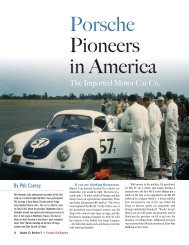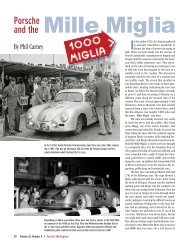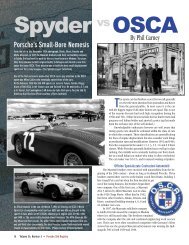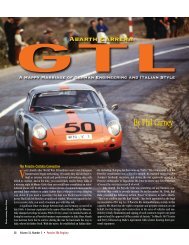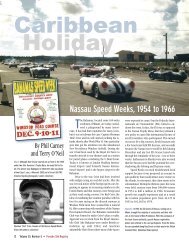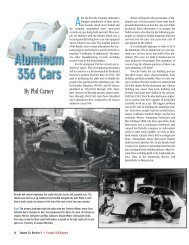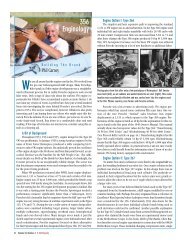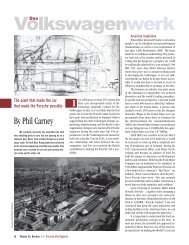Create successful ePaper yourself
Turn your PDF publications into a flip-book with our unique Google optimized e-Paper software.
The W-RS was developed in 1961. It finished 8th at Le<br />
Mans in 1963 but more importantly, the W-RS excelled in<br />
the European Hill Climb Championship in which <strong>Porsche</strong><br />
won in 1963. The W-RS continued racing until replaced by<br />
the <strong>Porsche</strong> 904.<br />
Below: <strong>Spyders</strong> were not often seen with their top up.<br />
The top was not available to keep the driver dry but<br />
rather to meet an FIA regulation that open sports car be<br />
equipped with a top. The FIA also dictated the car be<br />
able to carry a regulation size suit case.<br />
Bottom: The 718 GTR was a coupe version developed<br />
from the RS 61. Initially fitted with a variety of Type 547<br />
(1.5, 1.6 and 1.7-liter) engines, it was eventually upgraded<br />
to a 1.8-liter Type 587/3 and then a 2-liter Type<br />
719 engine. A GTR coupe driven Jo Bonnier and Carlo<br />
Mario Abate won the 1963 Targa Florio making it three<br />
wins at the event for a 718 car.<br />
24 Volume 35, Number 4 • <strong>Porsche</strong> 356 Registry<br />
Engine and Gearboxes<br />
Beca<strong>us</strong>e the Spyder cars were ready for the<br />
track before the four-cam design had been<br />
sorted out, a Type 528 (1500 Super) engine was<br />
originally installed in chassis 550-01 and -02<br />
(and for a time in 550-03 and 550-04). Indeed,<br />
it was with this engine that the cars won at Le<br />
Mans and Mexico in 1953. Other than those first<br />
two cars, development of the 550/550A was synonymo<strong>us</strong><br />
with development of the Type 547 engine.<br />
Over the years, the Type 547 would go<br />
through a number of revisions including one interesting<br />
anomaly which was the creation of a<br />
1098-cc four-cam made by reducing the bore to<br />
73 mm. This allowed <strong>Porsche</strong> to race <strong>Spyders</strong><br />
with a Type 547 engine in the 1.1 liter class. A<br />
car so equipped took first in class at Le Mans in<br />
1954, driven by Zora Ark<strong>us</strong> Duntov.<br />
The first 718 RSK was fitted with the original<br />
1.5 liter version of the four-cam but begin-<br />
<strong>Porsche</strong> archives (3)<br />
ning in early 1958 there was a new version<br />
called the Type 547/3 which <strong>us</strong>ed Weber 46<br />
IDM-1 carburetors. These were well suited to<br />
the larger 1.6-liter (Type 547/4) and 1.7-liter<br />
(Type 547/5) four-cams on which work started<br />
in 1957 and would be fitted in <strong>Spyders</strong> beginning<br />
in late 1959. There was also an un<strong>us</strong>ual<br />
1,606 cc four-cam <strong>us</strong>ed in the 1960 Le Mans<br />
race (which meant the cars were assigned to the<br />
Sport 2.0 class). Finally, a two-liter eight-cylinder<br />
boxer engine designated the Type 771 was<br />
fitted in some cars for formula racing.<br />
The 550 <strong>Spyders</strong>, both factory and c<strong>us</strong>tomer<br />
racers, <strong>us</strong>ed the Type 519 transaxle which<br />
originated back in 1951 for the 356 sports cars.<br />
The first four factory 550As got an upgrade in<br />
the form of the Type 669 transaxle which was a<br />
five-speed gearbox. For the c<strong>us</strong>tomer cars beginning<br />
with 550A-0111, the transmissions were<br />
<strong>Porsche</strong> Type 690 five speeds. When the 718 RSK<br />
appeared on the scene, transmissions bore a<br />
718 part number. One needs a bit of care in<br />
transmission identification. Type 718 transmissions<br />
contained Type 690 parts and the same<br />
was true of earlier transmissions.<br />
Personalization<br />
Although a consistent thread of development<br />
is present throughout the Spyder bloodline,<br />
the reader should not underestimate the<br />
amount of variations that existed in the series,<br />
with individual factory cars and with individual<br />
c<strong>us</strong>tomer cars. For example, there were constant<br />
efforts by the factory to strengthen and<br />
stiffen the chassis while simultaneo<strong>us</strong>ly making<br />
the cars as light as possible. Front and rear s<strong>us</strong>pension<br />
alterations were continuo<strong>us</strong>. Aerodynamics<br />
was constantly being investigated,<br />
looking at everything from tail fins to a huge rear<br />
airfoil tried by one c<strong>us</strong>tomer. For some hill<br />
climb cars, wheel arches were slightly raised<br />
and the s<strong>us</strong>pension had a greater travel range.<br />
As time went on, engine upgrades became more<br />
extensive in everything from displacement to<br />
cam profile, to carburetor selection, to oil cooling<br />
techniques. Optimization of hardware was<br />
continuo<strong>us</strong> with Werks cars being refined from<br />
one race to the next. The FIA was also constantly<br />
changing rules necessitating modifications to<br />
things like windshield size and luggage space.<br />
Changes are so numero<strong>us</strong> that every car would<br />
have to be described on a one-for-one basis to<br />
appreciate the full evolutionary progression.<br />
Today<br />
Of the first 14 two-digit 550s, half are<br />
known to still exist, many in the USA. Three cars<br />
were destroyed and the fate of the remainder is<br />
uncertain. Of the 76 Type 550/1500RS production<br />
cars, the existence of all but about 20 cars<br />
is known. How many of the Type 550A and Type



